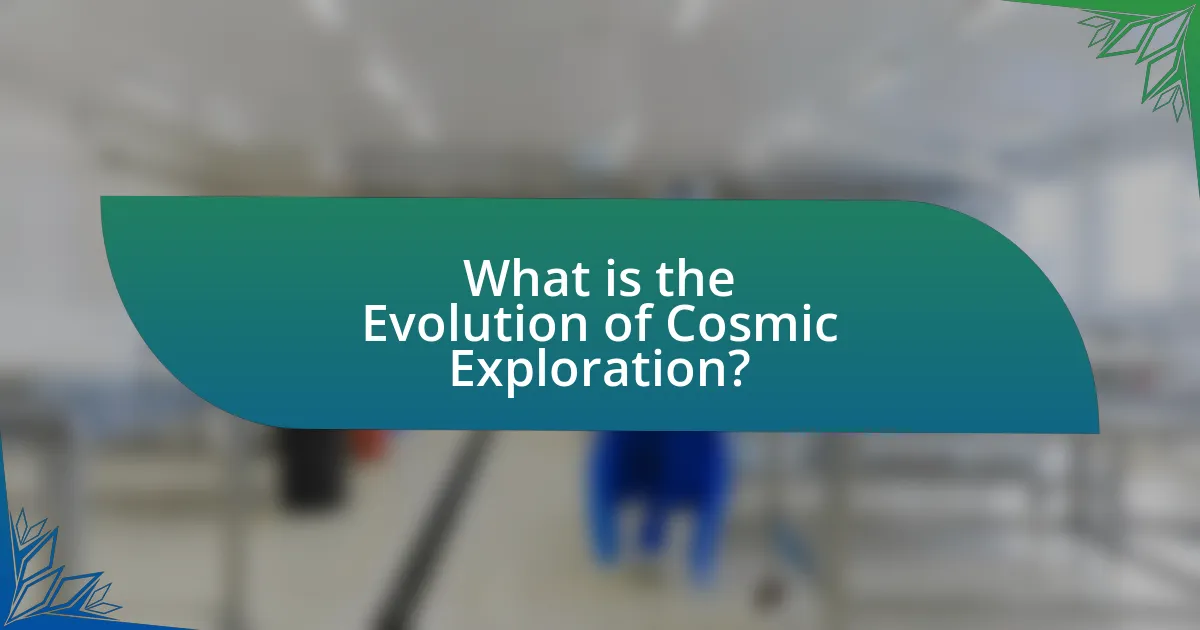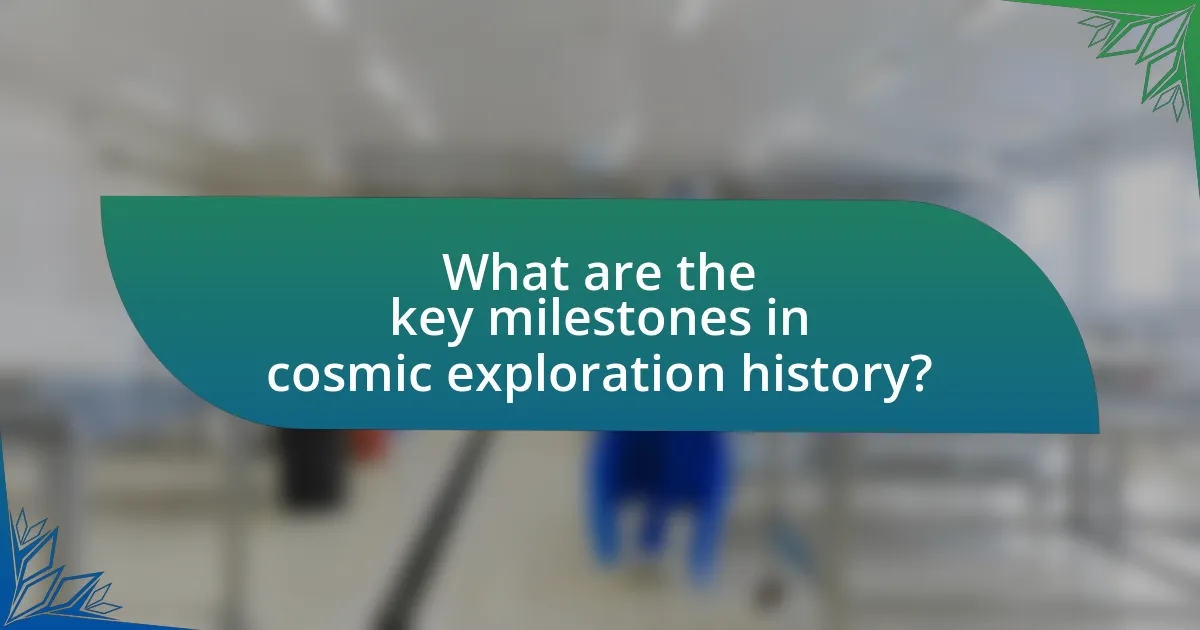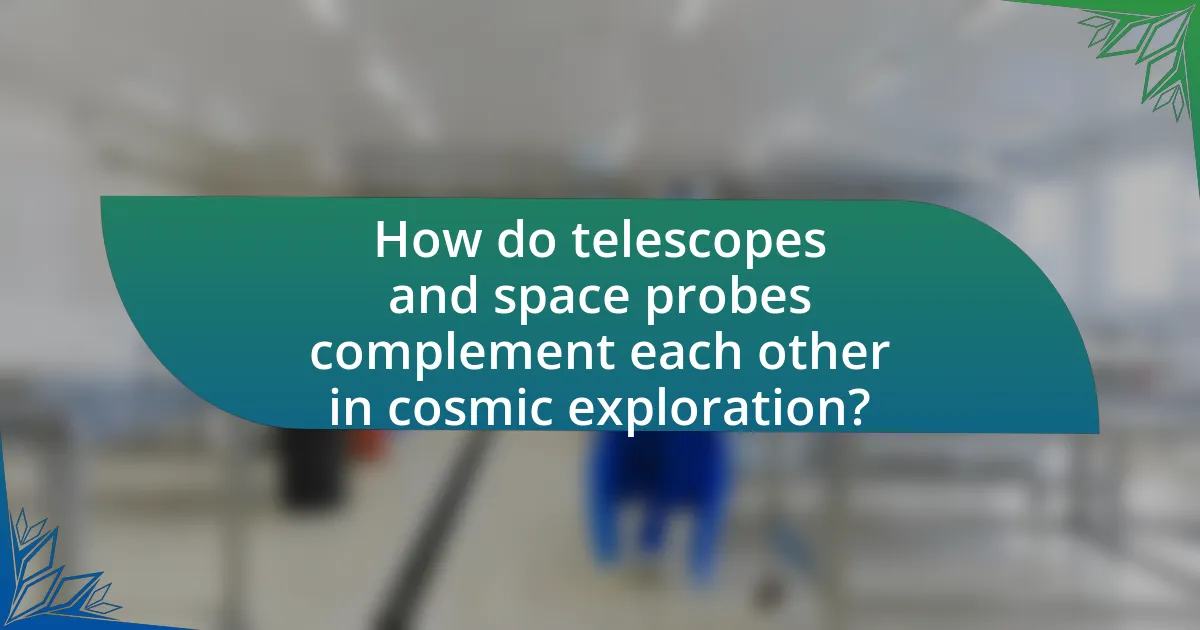The article examines the evolution of cosmic exploration, tracing its development from early telescopic observations in the 17th century to the advanced capabilities of modern space probes. It highlights key milestones, including the launch of Sputnik 1, the Voyager missions, and the Hubble Space Telescope, which have significantly expanded our understanding of the universe. The article also discusses the impact of early astronomical observations on scientific thought, the role of telescopes and space probes in gathering data, and the future prospects for cosmic exploration, including upcoming missions and technological advancements. Overall, it provides a comprehensive overview of how exploration methods have evolved and their contributions to our knowledge of the cosmos.

What is the Evolution of Cosmic Exploration?
The evolution of cosmic exploration encompasses the progression from early telescopic observations to advanced space probes. Initially, in the 17th century, telescopes allowed astronomers like Galileo to observe celestial bodies, leading to significant discoveries such as the moons of Jupiter. The 20th century marked a pivotal shift with the launch of artificial satellites, beginning with Sputnik 1 in 1957, which enabled the study of Earth’s atmosphere and space environment. This was followed by missions like the Voyager probes in the 1970s, which provided invaluable data about the outer planets and interstellar space. The Hubble Space Telescope, launched in 1990, further revolutionized our understanding of the universe by capturing high-resolution images and data across various wavelengths. Today, missions such as the Mars rovers and the James Webb Space Telescope continue to expand our knowledge, demonstrating the ongoing advancement in technology and methodology in cosmic exploration.
How did early astronomical observations shape our understanding of the cosmos?
Early astronomical observations fundamentally shaped our understanding of the cosmos by providing the first systematic insights into celestial bodies and their movements. Ancient civilizations, such as the Babylonians and Greeks, meticulously recorded the positions of stars and planets, leading to the development of early models of the universe, like the geocentric model proposed by Ptolemy. These observations enabled the identification of patterns in celestial events, such as eclipses and planetary retrogrades, which laid the groundwork for later scientific inquiry. The introduction of the telescope in the 17th century by Galileo further revolutionized this understanding, revealing details about celestial objects, such as the moons of Jupiter and the phases of Venus, which supported the heliocentric model proposed by Copernicus. These early observations and subsequent discoveries established a foundation for modern astronomy, influencing our current comprehension of the universe’s structure and dynamics.
What tools were used in the earliest observations of celestial bodies?
The earliest observations of celestial bodies were conducted using simple tools such as the naked eye, followed by basic optical instruments like the astrolabe and the telescope. The naked eye allowed ancient astronomers to track celestial movements and identify constellations. The astrolabe, developed in ancient Greece, enabled more precise measurements of the positions of stars and planets. The invention of the telescope in the early 17th century by figures like Galileo Galilei revolutionized celestial observation, allowing for detailed study of the Moon, planets, and stars, which was previously unattainable.
How did these early observations influence scientific thought?
Early observations, such as those made by Galileo and Kepler, significantly influenced scientific thought by challenging established beliefs and laying the groundwork for the scientific method. Galileo’s use of the telescope revealed celestial bodies that contradicted the geocentric model, leading to the acceptance of heliocentrism, which fundamentally altered humanity’s understanding of the universe. Kepler’s laws of planetary motion provided a mathematical framework that supported heliocentrism and emphasized the importance of empirical evidence in scientific inquiry. These observations fostered a shift from philosophical speculation to a reliance on observation and experimentation, which became central to modern scientific thought.
What role did telescopes play in the advancement of cosmic exploration?
Telescopes significantly advanced cosmic exploration by enabling astronomers to observe celestial objects in greater detail and at greater distances than ever before. The invention of the refracting telescope in the early 17th century allowed for the first detailed observations of planets, moons, and stars, leading to groundbreaking discoveries such as the moons of Jupiter by Galileo Galilei in 1610. Subsequently, the development of reflecting telescopes improved image quality and increased the size of observable objects, culminating in the construction of large observatories like the Mount Wilson Observatory in the early 20th century, which facilitated the discovery of galaxies beyond the Milky Way. Furthermore, advancements in telescope technology, including the Hubble Space Telescope launched in 1990, have provided unprecedented views of the universe, contributing to our understanding of cosmic phenomena such as black holes, dark matter, and the expansion of the universe. These advancements underscore the critical role telescopes have played in expanding our knowledge of the cosmos.
How did the invention of the telescope change our view of the universe?
The invention of the telescope fundamentally transformed our understanding of the universe by allowing astronomers to observe celestial bodies in unprecedented detail. Prior to its invention, the cosmos was primarily viewed through the naked eye, limiting knowledge to the visible planets and stars. With the telescope, Galileo Galilei’s observations in the early 17th century revealed the moons of Jupiter, the phases of Venus, and the detailed surface of the Moon, challenging the geocentric model of the universe and supporting the heliocentric theory proposed by Copernicus. This shift not only expanded the known universe but also laid the groundwork for modern astronomy, leading to the discovery of galaxies, nebulae, and the realization that the universe is vast and dynamic, fundamentally altering humanity’s place within it.
What are the major types of telescopes and their contributions to astronomy?
The major types of telescopes are optical, radio, infrared, ultraviolet, X-ray, and gamma-ray telescopes, each contributing uniquely to astronomy. Optical telescopes, such as the Hubble Space Telescope, have provided detailed images of celestial objects, enhancing our understanding of the universe’s structure and evolution. Radio telescopes, like the Arecibo Observatory, have enabled the study of cosmic phenomena such as pulsars and cosmic microwave background radiation, revealing insights into the Big Bang. Infrared telescopes, including the Spitzer Space Telescope, have allowed astronomers to observe cooler objects like dust clouds and distant galaxies, uncovering star formation processes. Ultraviolet telescopes, such as the Galaxy Evolution Explorer, have contributed to the study of hot, young stars and the interstellar medium. X-ray telescopes, like the Chandra X-ray Observatory, have provided data on high-energy phenomena, including black holes and supernova remnants. Finally, gamma-ray telescopes, such as the Fermi Gamma-ray Space Telescope, have advanced our understanding of the most energetic events in the universe, including gamma-ray bursts. Each type of telescope has significantly expanded our knowledge of the cosmos, revealing the complexities of astronomical phenomena.
How did the transition from telescopes to space probes occur?
The transition from telescopes to space probes occurred as advancements in technology enabled direct exploration of celestial bodies beyond Earth’s atmosphere. Initially, telescopes provided valuable data about distant objects, but limitations in resolution and atmospheric interference prompted the development of space probes. The launch of the first artificial satellite, Sputnik 1, in 1957 marked the beginning of space exploration, leading to missions like Voyager 1 and 2 in the 1970s, which provided unprecedented close-up images and data from the outer planets. These missions demonstrated the advantages of space probes, such as the ability to gather detailed information without atmospheric distortion, thus solidifying their role in cosmic exploration.
What technological advancements facilitated the development of space probes?
Technological advancements that facilitated the development of space probes include miniaturization of electronics, advancements in propulsion systems, and improvements in communication technology. Miniaturization allowed for the integration of sophisticated instruments into compact designs, enabling probes to carry more scientific equipment without increasing size or weight. Advancements in propulsion systems, such as ion thrusters and chemical rockets, provided the necessary power for long-duration missions and efficient travel through space. Improvements in communication technology, including high-gain antennas and data compression techniques, enhanced the ability to transmit large amounts of data back to Earth, ensuring that valuable scientific information could be relayed effectively. These advancements collectively contributed to the successful design and operation of space probes, enabling missions to distant planets and beyond.
How did the goals of cosmic exploration evolve with the introduction of space probes?
The goals of cosmic exploration evolved significantly with the introduction of space probes, shifting from observational astronomy to direct exploration of celestial bodies. Initially, telescopes allowed astronomers to observe distant planets and stars, providing limited information based on light and radiation. The launch of the first space probes, such as Mariner 4 in 1964, enabled close-up imaging and data collection from Mars, marking a transition to hands-on investigation of planetary environments. This evolution continued with missions like Voyager 1 and 2, which expanded our understanding of the outer solar system and interstellar space, demonstrating the capability of probes to gather comprehensive data on planetary atmospheres, magnetic fields, and potential for life. The success of these missions established a new paradigm in cosmic exploration, emphasizing the importance of in-situ measurements and paving the way for future missions to asteroids, comets, and beyond.

What are the key milestones in cosmic exploration history?
Key milestones in cosmic exploration history include the invention of the telescope in the early 17th century, which allowed astronomers like Galileo to observe celestial bodies for the first time. The launch of Sputnik 1 by the Soviet Union in 1957 marked the beginning of the space age and human-made objects in orbit. In 1969, NASA’s Apollo 11 mission successfully landed humans on the Moon, a significant achievement in human space exploration. The launch of the Hubble Space Telescope in 1990 revolutionized our understanding of the universe by providing high-resolution images of distant galaxies. Additionally, the Mars Rover missions, starting with Sojourner in 1997, have expanded our knowledge of the Martian surface and potential for life. Each of these milestones has contributed to our understanding of the cosmos and the development of space exploration technologies.
What were the first successful space probes and their missions?
The first successful space probes were Luna 2 and Pioneer 1, which marked significant milestones in space exploration. Luna 2, launched by the Soviet Union in 1959, became the first human-made object to reach the Moon, impacting its surface and providing crucial data about lunar conditions. Pioneer 1, launched by the United States in 1958, aimed to study cosmic rays and the Earth’s radiation belts, although it did not achieve its intended lunar orbit, it provided valuable information about the Earth’s environment. These missions laid the groundwork for future exploration and understanding of celestial bodies.
What discoveries did these early space probes make?
Early space probes made significant discoveries, including the identification of the Van Allen radiation belts, the detection of the first cosmic microwave background radiation, and the observation of the surface conditions on other planets. For instance, the Explorer 1 probe, launched in 1958, confirmed the existence of the Van Allen belts, which are zones of charged particles trapped by Earth’s magnetic field. Additionally, the Pioneer 10 probe, which flew by Jupiter in 1973, provided the first close-up images of the planet and revealed its intense radiation environment. These findings laid the groundwork for understanding planetary atmospheres and the broader cosmic environment.
How did these missions pave the way for future exploration?
These missions laid the groundwork for future exploration by advancing technology and expanding our understanding of the cosmos. For instance, the Apollo missions not only achieved human lunar landings but also developed critical technologies such as life support systems and spacecraft navigation, which are foundational for subsequent missions to Mars and beyond. Additionally, the Voyager missions provided invaluable data about the outer planets and their moons, demonstrating the feasibility of long-duration space travel and the importance of robotic exploration. This data has informed the design of future missions, such as the Mars rovers and the upcoming Europa Clipper mission, which aim to explore potentially habitable environments. Thus, the achievements and lessons learned from these missions directly influence the planning and execution of future space exploration endeavors.
What significant missions have shaped our understanding of the solar system?
Significant missions that have shaped our understanding of the solar system include the Voyager program, Mars rovers, and the Galileo spacecraft. The Voyager 1 and 2 missions, launched in 1977, provided unprecedented data about the outer planets and are now in interstellar space, offering insights into the heliosphere and cosmic rays. Mars rovers, such as Spirit, Opportunity, and Curiosity, have explored the Martian surface, revealing evidence of past water and potential habitability. The Galileo spacecraft, which orbited Jupiter from 1995 to 2003, delivered critical information about the planet’s atmosphere, moons, and magnetic field, enhancing our knowledge of gas giants. These missions collectively advanced our comprehension of planetary formation, atmospheric dynamics, and the potential for life beyond Earth.
What were the objectives of the Voyager missions?
The objectives of the Voyager missions were to explore the outer planets of the solar system and to gather data about their atmospheres, moons, and rings. Specifically, Voyager 1 and Voyager 2 aimed to conduct close-up studies of Jupiter, Saturn, Uranus, and Neptune, providing unprecedented images and scientific information. The missions also sought to investigate the heliosphere and interstellar space, contributing to our understanding of the solar system’s boundaries. Voyager 1, launched in 1977, became the first human-made object to enter interstellar space in 2012, while Voyager 2 followed in 2018, marking significant milestones in space exploration.
How did the Mars rovers contribute to our knowledge of the Red Planet?
Mars rovers have significantly enhanced our understanding of the Red Planet by conducting in-situ analysis of its surface and atmosphere. For instance, the Spirit and Opportunity rovers discovered evidence of past water activity, including hematite formations, which indicated that Mars once had conditions suitable for life. Additionally, the Curiosity rover has analyzed Martian soil and rock samples, revealing the presence of organic molecules and essential elements like carbon, hydrogen, and oxygen, which are fundamental for life. These findings have been crucial in shaping our knowledge of Mars’ geological history and its potential to support life, thus providing a clearer picture of the planet’s evolution and habitability.
What are the future prospects for cosmic exploration?
The future prospects for cosmic exploration include advancements in technology that will enable deeper space missions, such as the Artemis program aiming to return humans to the Moon by 2024 and establish a sustainable presence by 2028. Additionally, the James Webb Space Telescope, launched in December 2021, is expected to revolutionize our understanding of the universe by providing unprecedented views of distant galaxies and exoplanets. These initiatives are supported by increased international collaboration and investment in space agencies, with NASA’s budget for 2023 reaching $26 billion, reflecting a commitment to expanding human presence in space and enhancing scientific discovery.
What upcoming missions are planned for deep space exploration?
NASA’s Artemis II mission, scheduled for 2024, aims to send astronauts around the Moon, marking a significant step in deep space exploration. Additionally, the European Space Agency’s Jupiter Icy Moons Explorer (JUICE), set to launch in 2023, will study Jupiter’s moons, focusing on Europa, Ganymede, and Callisto, to assess their potential for hosting life. Furthermore, NASA’s Psyche mission, targeting the metallic asteroid Psyche, is planned for launch in 2023 to provide insights into planetary formation. These missions reflect ongoing efforts to expand our understanding of the solar system and beyond.
How might advancements in technology change the landscape of cosmic exploration?
Advancements in technology will significantly enhance the landscape of cosmic exploration by enabling more precise data collection, improved propulsion systems, and advanced communication methods. For instance, the development of artificial intelligence allows for autonomous spacecraft to analyze data in real-time, leading to quicker decision-making and more efficient mission operations. Additionally, innovations in propulsion technologies, such as ion drives and solar sails, can reduce travel time to distant celestial bodies, making missions to Mars or beyond more feasible. Furthermore, advancements in communication technology, like laser-based systems, can facilitate faster data transmission back to Earth, allowing scientists to receive and analyze information more rapidly. These technological improvements collectively expand the capabilities and scope of cosmic exploration, as evidenced by missions like the James Webb Space Telescope, which utilizes cutting-edge technology to observe the universe in unprecedented detail.

How do telescopes and space probes complement each other in cosmic exploration?
Telescopes and space probes complement each other in cosmic exploration by providing distinct yet synergistic methods of gathering data about the universe. Telescopes, such as the Hubble Space Telescope, capture light from distant celestial objects, allowing astronomers to analyze their composition, distance, and movement through spectroscopy and imaging. This observational data is crucial for understanding cosmic phenomena and forming hypotheses about the universe’s structure.
In contrast, space probes, like the Voyager missions, travel to specific locations in the solar system and beyond, collecting in-situ measurements of planetary atmospheres, magnetic fields, and surface compositions. This direct data collection offers insights that cannot be obtained through remote observation alone, such as the detailed geology of Mars or the atmospheric conditions of Jupiter.
The combination of these two approaches enhances our understanding of the cosmos; telescopes can identify targets of interest for further investigation by space probes, while probes can validate and expand upon the findings made through telescopic observations. For instance, the data collected by the Mars rovers has confirmed and refined theories initially proposed based on telescope observations of Martian features. Thus, the interplay between telescopes and space probes is essential for a comprehensive exploration of the universe.
What unique advantages do telescopes offer compared to space probes?
Telescopes offer unique advantages over space probes primarily through their ability to observe a wide range of celestial phenomena from a fixed location, allowing for continuous monitoring and long-term data collection. Unlike space probes, which are limited to specific missions and destinations, telescopes can be used to study multiple objects and events over extended periods, such as supernovae or variable stars. This capability is exemplified by the Hubble Space Telescope, which has provided over three decades of continuous observations, yielding invaluable data on the expansion of the universe and the formation of galaxies. Additionally, telescopes can be upgraded with new instruments and technology without the need for a physical return to Earth, enhancing their observational capabilities over time.
How do ground-based telescopes enhance our understanding of distant galaxies?
Ground-based telescopes enhance our understanding of distant galaxies by providing high-resolution images and detailed spectral data that reveal their composition, structure, and dynamics. These telescopes utilize adaptive optics technology to correct for atmospheric distortion, allowing astronomers to observe fine details in galaxy formations and interactions. For instance, the Keck Observatory in Hawaii, with its large aperture and advanced adaptive optics, has enabled the study of galaxy formation and evolution by capturing light from galaxies billions of light-years away, leading to discoveries about star formation rates and the presence of dark matter.
What limitations do telescopes face that space probes can overcome?
Telescopes face limitations such as atmospheric interference and fixed observational positions, which space probes can overcome by operating outside Earth’s atmosphere and moving closer to celestial objects. Telescopes are affected by atmospheric turbulence, which distorts images and limits resolution, while space probes can capture clearer images and data without atmospheric distortion. Additionally, telescopes are stationary and can only observe from specific locations on Earth, whereas space probes can travel to various locations in the solar system, allowing for direct measurements and observations of planets, moons, and other celestial bodies. This capability enables space probes to gather data that telescopes cannot, such as surface composition and environmental conditions.
How do space probes provide data that telescopes cannot?
Space probes provide data that telescopes cannot by directly measuring environmental conditions and surface compositions of celestial bodies. Unlike telescopes, which rely on light and other electromagnetic radiation from distant objects, space probes can conduct in-situ analysis, allowing them to gather detailed information about temperature, atmospheric pressure, and chemical composition. For example, the Mars Curiosity rover has analyzed Martian soil and rock samples, providing insights into the planet’s geology and potential for past life, which telescopes cannot achieve. Additionally, space probes can capture high-resolution images and data from close proximity, such as the detailed surface mapping conducted by the Lunar Reconnaissance Orbiter, which offers a level of detail unattainable by ground-based or orbital telescopes.
What types of measurements can only be obtained through space probes?
Space probes can obtain measurements of planetary atmospheres, surface compositions, and magnetic fields that cannot be acquired through telescopes. For instance, the analysis of atmospheric gases on Venus and Mars by the Venus Express and Mars Atmosphere and Volatile EvolutioN (MAVEN) missions provided direct data on their chemical compositions, which is unattainable from Earth-based observations. Additionally, space probes like the Juno spacecraft have measured Jupiter’s magnetic field and gravitational field, offering insights into its internal structure that ground-based telescopes cannot provide. These measurements are crucial for understanding planetary formation and evolution.
How do space probes contribute to real-time data collection in cosmic exploration?
Space probes contribute to real-time data collection in cosmic exploration by utilizing advanced instruments to gather and transmit data directly from their locations in space. These probes are equipped with sensors that measure various cosmic phenomena, such as radiation levels, magnetic fields, and atmospheric conditions, allowing scientists to receive immediate information about celestial bodies and environments. For instance, NASA’s Mars rovers, like Curiosity and Perseverance, send back high-resolution images and chemical analyses of Martian soil and atmosphere in real-time, enabling ongoing research and immediate responses to findings. This capability enhances our understanding of the universe and supports timely decision-making for future missions.
What practical tips can enhance our understanding of cosmic exploration?
To enhance understanding of cosmic exploration, individuals should engage with current scientific literature and participate in public outreach programs. Reading peer-reviewed journals, such as “The Astrophysical Journal,” provides insights into recent discoveries and methodologies in cosmic research. Additionally, attending lectures or workshops hosted by institutions like NASA or local planetariums fosters direct interaction with experts, allowing for deeper comprehension of complex topics. Engaging with interactive simulations and educational platforms, such as NASA’s Eyes on the Solar System, further solidifies knowledge by visualizing cosmic phenomena and missions.
How can amateur astronomers contribute to cosmic exploration efforts?
Amateur astronomers can significantly contribute to cosmic exploration efforts by participating in data collection and analysis, which enhances scientific research. They often engage in observing celestial events, such as supernovae or variable stars, and report their findings to professional astronomers, thereby expanding the dataset available for study. For instance, the American Association of Variable Star Observers (AAVSO) has documented thousands of observations from amateurs that have been crucial for understanding stellar behavior. Additionally, amateur astronomers utilize advanced technology, such as telescopes equipped with cameras, to capture high-resolution images of astronomical phenomena, which can be shared with research institutions for further analysis. This collaborative approach not only aids in the discovery of new celestial objects but also fosters a community of enthusiasts who contribute to the broader scientific knowledge base.
What resources are available for those interested in learning more about cosmic exploration?
Numerous resources are available for individuals interested in learning about cosmic exploration, including books, online courses, documentaries, and websites dedicated to space science. Notable books such as “Cosmos” by Carl Sagan and “Astrophysics for People in a Hurry” by Neil deGrasse Tyson provide foundational knowledge. Online platforms like Coursera and edX offer courses from institutions like MIT and Stanford, covering topics from astronomy to space missions. Documentaries such as “The Universe” series and “Cosmos: A Spacetime Odyssey” visually explore cosmic phenomena and historical missions. Additionally, websites like NASA’s official site and the European Space Agency provide up-to-date information on ongoing research and missions, making them valuable resources for enthusiasts and learners alike.




